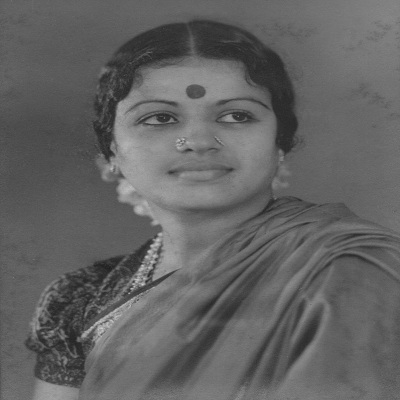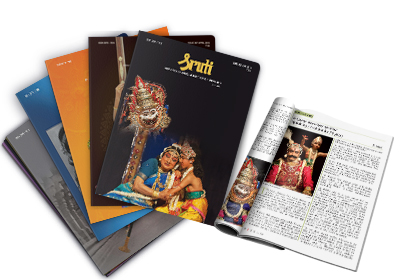
The following is an excerpt from MS and Radha by Gowri Ramnarayan. For limited period offer of a special price of `550 on the book, go to www.sruti.com or at Chennai at Sruti, 9, Cathedral Road, Chennai 600086.
One day an old man walked down the street and smiled at the child as he passed by. He wore a saffron veshti and ash marks on forehead and arms, a rudraksharound his neck, and carried a bronze kamandala. The child smiled back shyly, liking him on sight. He looked devout and kind-hearted. After that, she continued to see him everyday – fresh from his bath, with the same sweet special smile for her.
One day he stopped. “Child, I want to teach you. Will you learn from me?” he asked. Surprisingly, Kunja, who was so scared of strangers, immediately nodded “Yes”. He promptly sat down on the doorstep, closed his eyes, folded his hands and began with a sloka, Ghrita guda payasam…
The child imitated his gestures carefully and repeated the words after him. The lessons were launched. Strangely enough, he did not teach her Sanskrit, the language of the scriptures, nor her mother tongue Tamil, but the obsolete Grantha script that survives in old books, in inscriptions on temple walls, and on copper plates maintaining old records.
The family watched these ‘classes’ with astonishment. Perhaps they were amused by this white-haired man teaching a tiny tot, but no one stopped them. Poor wandering soul he may have been, and craggy with age, but as a scholar and renunciate, the old man was accorded respect. However, Vadiva and Sakti found it impossible not to laugh when they saw him. They teased Kunja dreadfully. Sakti called the teacher ‘Old dhritakula payasam’, after the funny sounding prayer he recited at the start of each day.
The lessons continued until eventually the guru returned to Kasi, from where he had come south on a pilgrimage to spend the winter month of Dhanur in the sacred birthplace of Minakshi, another form of Visalakshi whom he worshipped on the ghats of the Ganga. That is how the first script the child learnt was Grantha, and an old pilgrim whose name Kunja never knew, and nobody else cared to ask, became her first guru.
When the old man stopped coming, Kunja studied up to class five in a regular school. She might have continued but for a severe beating from a teacher for no reason that she could understand. The fright intensified her whooping cough so much that the elders at home decided to stop her formal schooling. Kunja did not miss school. She had been scared of teachers and classmates. Staying at home was a relief.
Her education was by no means over. There was so much to learn from Shanmukhavadivu. She never sat down to give her children formal lessons. It was more a matter of picking up as she practised, or taught the few students who came to her, and singing with her as she played the veena.
Vadiva was chosen to learn the veena, but Kunja’s voice made the mother chose Srinivasa Iyengar to train her in vocal music. He was the younger of the Srirangam Brothers who performed together, and represented a dignified school.
On an auspicious day and hour, a small puja was performed at home; a coconut was cracked and offered in worship. A plate of vetrilaipakku, pazham and pushpam – the propitious betel leaves, fruit and flowers – were placed before the guru, a mat was unrolled in the front room and the tambura placed on it. Kunja prostrated before God, her mother and the guru. She sat down on the mat for her first lesson. A shiver ran through her small frame. She wondered how she would overcome her diffidence before a stranger and learn to sing. There was also the excitement at age six of being considered ready to start formal lessons.
The guru checked the tambura strings. They were correctly tuned. He began to pluck them. Kunja’s hesitations vanished. He sang out loud and clear: Sa ri ga ma pa dha ni sa. The child repeated the notes after him in three speeds.
The guru must have been caring and affectionate as he laid a proper foundation by going through the beginner’s exercises – sarali varisai, alankaram and gitam. Sadly, he did not live long enough to guide her as he wished to. The guru went back to his hometown promising to return speedily. But death put an end to that hope. For Kunjamma this was a big shock. What was going to happen to her now? How could she go on without his guidance?
It took time for Kunja to recover and resume her music. She practised for long hours and with great involvement. Fortunately she was used to discipline, to being woken up at 4 am, given a glass of neeraharam – a nifty name for water drained from the top of the previous day’s leftover rice soaked overnight. This had to sustain her through swara exercises sung in akaram, ukaram and ikarammodes in three speeds. A varnamor two followed. At 7 am, a glass of thin hot coriander coffee signalled the end of the session. Evenings were given to ragas and the kritis which enshrined the wealth of their melody.
The sruti box was unknown and the harmonium was deemed unsuitable for drone accompaniment. And so the child learnt the art of tuning the tambura to perfect sruti fidelity and maximal resonance very early on. And then the sound overwhelmed her. She had to make a conscious effort to break that enchantment in order to start singing in the predawn dark, lit by an agal vilakku, the little clay lamp. All her life, Subbulakshmi was to be hypnotised by the sound of tambura strings. There was clinical absorption in her act of tuning the two tamburas, Lakshmi and Sarasvati, each with ivory vignettes of the goddesses on the stem. With multi-stringed Miraj tamburas, this became sheer obsession. (She rewarded daughter and vocal accompanist Radha with her warmest smile whenever she achieved perfect tuning in the twin tamburas). Time stood still as she played the strings and sang slow phrases, pausing on different notes to exult, “Can you hear the gandhara now? Madhyama? Nishada?”Then, reluctantly, she would place the tambura on the mat, touching the stem with her fingers and pressing them lightly on her eyes in a gesture of worship.
Even her childhood games revealed Kunja’s absorption in the art form. One of them started with tuning the tambura carefully until the plucked strings cast a spell with their resonance. Eyes closed, she was lost in another world. Then she stopped, sang without the tambura, and plucked the strings again to check if she had stayed true to sruti. Throughout the day, in between household jobs, she kept returning to the tambura to see if she could recall that pitch steadily and accurately.
Singing on the stage happened so naturally that it seemed part of the daily routine. Kunja’s first public appearance was something to recall with laughter.
The child was making mud pies in the backyard when an uncle picked her up, dusted her skirt, washed her hands and took her straight to the dais at the nearby Setupati school where her mother was giving a concert for an audience of fifty, a large gathering in those days. The child was used to seeing her mother play the veena for visitors at home. She felt no fear when Shanmukhavadivu asked her to sing a Marathi bhajan, Anandhaja. At once, unhesitatingly, Kunja sang the song she knew so well. She was too young to appreciate the significance of the smiles and applause. In fact, she was eagerly wondering how soon she could get back to her mud pies!
The atmosphere at home fanned Kunja’s love of music. Shanmukhavadivu was a worthy though by no means legendary artiste like her illustrious senior contemporary Veena Dhanammal who lived in Madras.
Grandmother Akkammal had been an unremarkable violinist, who probably took up that instrument as a second-level performer had more chances as an accompanist than as the main artiste. She must have died before the children were born as they hardly remembered her.
Musicians who came to Madurai to give concerts rarely left without greeting Shanmukhavadivu, stalwarts like the Karaikudi Brothers, Mazhavarayanendal Subbarama Bhagavatar, Nagasvaram Ponnuswami Pillai, violinist Malaikottai Govindaswami Pillai, and Ariyakudi Ramanuja Iyengar among them. They were in no hurry. They tucked vetrilaipakku into their cheek, or took a pinch of snuff, and talked endlessly about great music and great musicians. Somebody would begin, “Do you know what happened when Konerirajapuram Vaidyanatha Iyer was scheduled to sing after Madurai Pushpavanam Iyer? After listening to Pushpavanam Iyer’s concert the singer said to the organizers with tears in his eyes, ‘The young man has rained sugar and honey today. I am deeply moved. I can’t sing now. Let me come back and sing tomorrow.’”
Those visitors rarely left without singing or playing their instrument for the hostess. A nod from Shanmukhavadivu was applause. Sometimes she would pluck the strings and start playing as they sang. Usually Kunja would be asked to sing something. A nod meant satisfaction. A terse “You will come up” was approval. If they taught her a song, it meant high praise.
Local musicians, too, would drop by. Veena players were always anxious to impress Shanmukhavadivu. Some of them played dreadful music. Subbulakshmi recalls, “The veena is a delicate instrument. It has to be plucked and stroked gently, but this vainika pulled and grabbed and pushed and banged. What made it worse was that he had chosen to play the soulful raga called Sahana. And he chose to repeat the words Rakshasa Bhima, or terrible demon. Vadiva, Sakti and I could not stop our giggles. Mother glared icily at us, but how could we stop laughing, especially when, with an explosive twang, the string broke and curled up with a squeak!”
Kunja attended few concerts but listened to a lot of music on the radio. The family could not afford a radio but the neighbour’s could be heard clearly if she sat beside the window halfway up the staircase. The radio introduced her to Hindustani music. How enchanting it was to hear Abdul Karim Khan, Amir Khan or D.V. Paluskar, their voices sweetened by the silence of the night! Kunja would not have imagined then that one day she would sing Paluskar’s signature bhajan Thumak chalat Ramachandra in a Tamil version (Engum nirai nadabrahmam) and in a film in which she played the heroine, Sakuntalai!
Watching the world from the staircase window introduced her also to fashion when she saw the girls in the opposite house dabbing something white on their faces. All the cosmetics she knew were turmeric and gram flour, homemade maito line the eyes and chaandupaste stored in a coconut shell for the pottu on the forehead. Knowing nothing of talcum powder, the girl once rubbed her hands along the whitewashed wall and tried the effect on her face. The furious mother gave her a slap for being stupid.
The neighbour’s gramophone was sheer magic. Inspired by the gramophone company’s logo of the dog listening to his master’s voice, the little girl would make a paper cone and sing into it for hours. This dream came true sooner than she expected when her mother took Kunja to the recording studio in Madras. Kunja was ten years old when she recorded her first disc, singing at an impossibly high pitch.
Shanmukhavadivu had chosen to live with a single partner. Through the long years of career establishment and longer years of celebrityhood, Subbulakshmi never mentioned her father. Many assumed that it was the brilliant vocalist Madurai Pushpavanam Iyer.
Finally, in the mid 1980s, when her journalist grandniece interviewed her for a children’s magazine, Subbulakshmi spoke about her father for the first time. Unasked. And the words locked in her heart tumbled out in a rush of emotion. To someone belonging to a different generation and a different world, it was amazing that she felt no rancour or sense of ill usage. She thought of his affection, devotion and piety, never questioned even by tone or look the social code that had made it impossible for her to live with the man she obviously adored. Shanmukhavadivu was undemonstrative, seemingly dour. As Subbulakshmi talked, it was easy to see how much she had looked to her father for affection.
Kunja’s father Subramania Iyer lived with his family on a street nearby. He was an advocate. His heart was not in the courtroom, but in his puja room with his ishta deivam Sri Rama. Every year he celebrated the Rama Navami festival with great love and care. The portrait of Rama, splendidly decorated with flowers, was taken from his puja room, placed on a saarattuor horse-drawn buggy and taken through the streets in a grand procession. Kunja, Vadiva and Sakti attended the function.
“Appa had other children. How proud I felt when he picked me up and made me sit beside him on that saarattu! I snuggled up to him, and thought I was the luckiest girl alive!”
The procession returned to the father’s house. The portrait was carefully taken down, and into the house. After puja, the father led the group in bhajanai and namasankirtanam. The distribution of sundal marked the end of the proceedings. Kunja walked home with the uneaten sundal in her hand.
From her childhood, friends and family knew Subbulakshmi by her pet name Kunjamma, but her father had another special name for her. “He always called me ‘Rajaathi, my little princess!’ Sometimes he would make it more affectionate and say, ‘Rajaathippa!’ in the caressing tone he had. He was very proud of my singing. ‘I will find you a husband who will cherish your music,’ he promised. Then he would laugh and tease me ‘So how about a nice boy who plays the tambura? Do you fancy such a husband?’ How I laughed with him! My father died when I was barely ten.”
Until the 1990s, no mention was made of Subramania Iyer in public, until Justice M.M. Ismail, a Tamil scholar who had been consulted through the recording of lyrics from the Kamba Ramayanam, spoke on the occasion of its release, and made glowing references to him as an able lawyer and a good human being. He also gifted Subbulakshmi with an enlarged portrait of her father, which was hung up in her house beside the old photograph of Shanmukhavadivu with the veena across her lap. If anyone remarked on the close resemblance between father and daughter, Subbulakshmi would beam with joy pure and simple – just how much, could be sensed in her frequent references to him ever after. “He was a man of character, so affectionate, so full of bhakti…”
Those who heard Subbulakshmi sing Bhadrachala Ramadasa’s kriti Ennaganu Ramabhajana were always transported when she repeated the line Rama, rama, rama yenutsu with exquisite poignancy. Now her grandniece knew why. She also realised that grandaunt Kunjamma was an inspiring role model, not only for the miracle of her music, but because she represented in her simple, everyday life, the values of an ancient culture – humility, compassion, consideration for others and unwavering principles of conduct. They were ingrained in her from childhood.
Her quest for perfection, sincerity of effort and concentration were not reserved for the stage. They were visible in the camphor light that she circled around the gods and gurus in her puja room, just as she remembered her father doing so long ago, in a home where she was a mere visitor. That is why she filled you with the same rapture when she sang a prayer at home, as she did on the concert stage with her eyes-closed finale Kurai onrum illai – ‘Lord, I have no regrets’.


